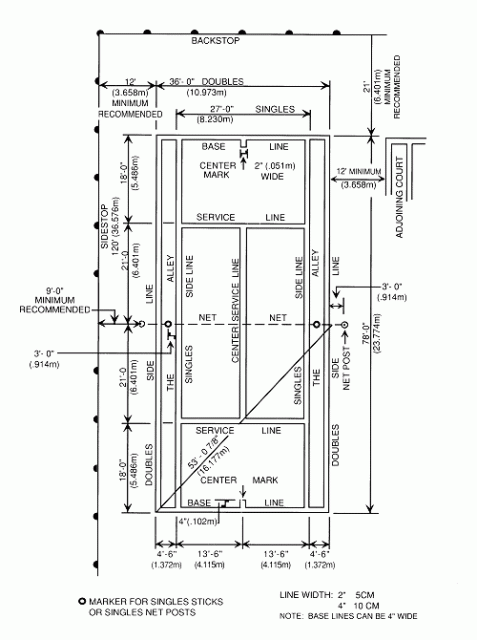Many people contemplating the installation of a tennis court have lots of questions.
If you don’t find your answer here, please Contact Us for information specific to your project. Our goal is to build you the very best tennis facility available.
What is the recommended area for a tennis court?
The size of a single court is recommended at 60′ x 120′. The minimum required dimensions per the International Tennis Federation is 56′ x 114′. Stadium courts should be 66′ x 132′ to allow for judges. Multiple court complexes are recommended for each court to be 60′ x 120′, which allows 24′ between the courts. The preferred minimum between courts is 18′ and the absolute minimum space between courts 12′. This diagram below shows the layout and measurements of a tennis court per USTA regulations.
What is the slope of a tennis court?
What kinds of substrates are required?
At five years structural cracks have developed or are developing, as well as birdbaths (depressions in the asphalt). At 20 years major restoration work is required. Concrete can either be reinforced or post-tensioned. Reinforced concrete courts are recommended to be 5″ thick with #4 rebar placed 12″ on center, both directions. Each 1⁄2 court should be cast at one time, with no intervening joints. With no jointing, expect random cracking to occur, but due to the rebar, they will open only minimally.
Post-tensioned concrete utilizes steel cables in a plastic sheathing, which are placed in a grid through out the slab. A minimum of one full-court is placed at one time, and the cables are stressed to 33,000 psi once the concrete has reached a minimum strength of 2,700 psi (typically 5 to 7 days). Although random cracking is likely to occur, the cable compression will keep them to a hairline crack and not allow displacement. This is the most structurally sound method of construction. Substrates for clay courts should be properly compacted road base or non-expansive native soils. For Sand-Filled Turf courts, asphalt or concrete is recommended, although they can be constructed on properly prepared road base materials.
What kinds of surfaces are available?
The cushioned surface can either be an acrylic-and-rubber build up system or a textile product. There are several options for each type of cushioned surface, all with varying degrees of cushion. Sand-filled Turf surfaces can be installed on either concrete, asphalt or a properly prepared gravel base. These surfaces are finding a niche in the industry as a rehabilitative surface, being placed over severely cracked substrates.
There are several manufacturers of these surfaces, each with certain attributes. Har-Tru Clay surfaces are comprised of aggregate bases, with crushed granite as the actual play surface. Most installations are new facilities, although it is becoming more common to rebuild existing facilities by overlaying the existing courts with a clay court system.
What resurfacing options are available for hard courts?
The Armor Crack Repair System, is very promising. The sand-filled turf systems and some of the textile cushion systems can be installed over cracked substrates to prevent the cracks from interfering with play. These surfaces are free-floating over the surface area of the court to allow the cracks to continue movement without reflecting through.
What size fences are required for tennis courts?
As the majority of tennis balls will bounce to the ends or the corners, the high fence is required at each end, returning along the sides for a minimum of 20′. At this point, the side fences can be reduced in height, or even eliminated, to allow for viewing onto the court.
What types of fencing are recommended?
Options for chain link fencing include Galvanized chain link systems and Vinyl-coated chain link fence systems.
Options for fencing can include wooden posts and rails with chain link fence fabric, wooden picket fences, or a soft-fence, which is a nylon mesh netting.
Should an architect and/or engineer be involved with my project?
In instances where a tennis court is to be constructed on an existing landscaped lot, or if the owner has a plan for amenities and plantings, an architect would not be required. Although not required, a soils report prepared by a soils engineer can offer invaluable insight to sub-surface conditions, and recommend procedures to overcome any problems that may lie beneath.
We do not generally include this cost in our proposals, but we do recommend that the owner consider such. Problems that may be encountered might be expansive soils, underground springs, or substantial organic materials that may deteriorate.
Typically, a property owner has already had this evaluation done when constructing structures on it. We can prepare engineered drawings for permitting and construction, for the tennis court, drains, retaining walls, lighting, etc.
Hard Court Tennis Surfaces
Clay
One of the next types of tennis court surfaces is clay. The color of the clay can range from gray, to green, to red. These tennis court surfaces are slow because the ball bounces slowly and has less forward motion. Therefore, matches on clay surfaces usually last longer because it is harder to achieve a winning shot. These tennis court surfaces are favored by defensive players who tend to play from the baseline.
Hard
Hard tennis court surfaces are the most common. They can be made of cement, asphalt, or plastic. These tennis court surfaces are slower than grass courts, but faster than the clay designs. Hard surfaces have the advantage of giving the ball the most predictable bounce, so you are less likely to misjudge the bounce. Also, these surfaces are much easier to maintain as you can use a broom or blower to keep them clean.
Carpet
One of the final types of tennis court surfaces is carpet. These surfaces have various playing characteristics. This depends on the texture, thickness, and materials used to make the carpet. These tennis court surfaces are most often used indoors. However, carpets that are made from synthetic grass are commonly used both outside and indoors.
New Construction, Reconstruction & Renovation
Site Planning considerations:
1. Proper dimensions and spacing between and around courts, particularly on irregular or limited sites or where liability issues are a special concern.
2. Orientation of courts, site layout & planning.
3. Drainage including slope and drainage of courts, site drainage and storm water management.
4. Soil issues, base construction.
5. Evaluating surfacing options.
6. General information, advice and comparison of accessories and amenities.
7. Climatic considerations.




